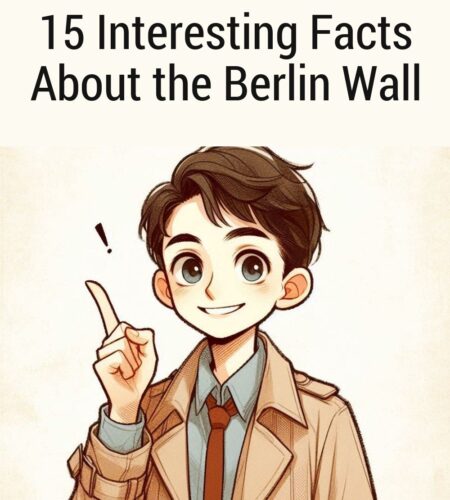Introduction:
The Berlin Wall was a defining symbol of the Cold War, separating East and West Berlin for almost three decades. It first went up on August 13, 1961, and though it only lasted until November 1989, it remains one of the most infamous and important political constructions in modern history. Here are 15 interesting facts about the Berlin Wall.
Fact 1: Most of the Wall Stood for 28 Years
People in Germany and around the world were in shock when the Berlin Wall was erected in 1961, spurred into action by the Soviet Union’s fear of mass emigration from East to West. For the majority of its lifespan, the wall stood intact as an notorious yet seemingly immovable symbol of the Cold War. It took a historic event and popular movement to bring it down in November 1989, some 28 years after its construction.
Fact 2: The Berlin Wall was not one Wall
The Berlin Wall was actually composed of two walls with an area in between known as the Death Strip, with several additional walls and fortifications inside. This was done to heighten the ineffectiveness of an attempted escape from the East. The inner wall was made of concrete, while the outer wall was constructed out of a variety of materials such as bricks and cinder blocks. There were also watch towers and 296 watch houses.
Fact 3: It Was Originally Intended to Last Forever
When it was first erected, it was assumed that the Berlin Wall would last forever. This had a significant impact on how it was constructed and the materials used to construct it. Many people were surprised when, only 28 years later, the wall was brought down by a peaceful protest in 1989.
Fact 4: Almost 800 Escapees were Killed
In the nearly three decades it stood, around 5,000 people made ambitious but dangerous attempts to escape the East by crossing or breaching the wall. Tragically, almost 800 people lost their lives in these attempts. It wasn’t until the historic events of 1989 that the wall brought down without significant bloodshed.
Fact 5: The Berlin Wall Was Painted with Graffiti
The fall of the Berlin Wall brought out a wave of different reactions from people living in Germany. Along with celebratory ringing of the bells of the churches, the wall was also covered in political graffiti. It was used as a platform to express different political views and give a voice to the people of East Berlin.
Fact 6: The Berlin Wall Split up Families
One of the most unfortunate effects of the wall was the impact it had on families living in Germany at the time. In many cases, family members found themselves in different parts of the city and could not meet each other due to the separation the wall had caused. In fact, a large gap in the middle of Berlin was known as the “Family Division” as this was the only place where East and West Berliners could meet and interact.
Fact 7: The Berlin Wall Led to Increased Air Pollution in East Berlin
One of the lesser known effects of the Berlin Wall was a dramatic increase in air pollution in East Berlin. This was due to the fact that factories and industries located in East Berlin found their access restricted and had to rely on their own resources to fuel their operations. This led to a dramatic increase in the amount of pollutants released into the air in East Berlin compared to its western counterpart.
Fact 8: The Berlin Wall Severed the Berlin Transit System
An essential part of any city is its public transport system and the Berlin Wall had a devastating impact on the Berlin public transit system. The extensive network of U-Bahn (underground) and S-Bahn (overground) subway lines were effectively divided into two separate networks, greatly affecting the people living in the city and reducing the accessibility of public transit.
Fact 9: The Berlin Wall Included Exclusions Zones
The Berlin Wall was not merely a line on a map; it extended through large parts of the city, including death strips and exclusion zones. These areas were prohibited for civilians and meant to prevent the passage of unwanted people from East to West by controlling the flow of traffic.
Fact 10: There Were Underground Tunnels Built in Order to Escape
As the Berlin Wall became more and more fortified, people seeking to escape East Berlin had to find more creative means of doing so. This led to the construction of a network of underground tunnels that extended far beyond the wall’s boundaries. Most of these tunnels were discovered, but some were successful in helping people escape to West Berlin.
Fact 11: The Wall Was Cut Into Small Pieces
When the Berlin Wall was officially brought down, the government decided to cut the wall into small pieces so it could be taken home by its citizens as a souvenir. This remarkable action helped to create closure for those who had suffered from the effects of divided Germany and also allowed its citizens to take part in the historic reunification of the city.
Fact 12: The Fall of the Berlin Wall Led to Unification
The fall of the Berlin Wall marked a period of dramatic change in Germany and for Europe in general. Arguably, the most significant event resulting from the wall’s fall was the reunification of Germany in October 1990, signalling a profound shift in the socio-technical environment of Europe as a whole.
Fact 13: There Was a Berlin Wall Rally Car Race
In an attempt to draw attention to the separation of East and West Berlin, rally driver Thomas avec Schwägermann organised a car race that was specially designed to take place on the Berlin Wall. The race took place in 1988 and saw cars from both sides of the wall competing on the border line. It was an unprecedented event that provided a glimpse of hope and unity during a troubled period of history.
Fact 14: There Was a Controversial Balloon Escaping Incident
There have been some remarkable stories coming out of the Cold War period in Berlin, and one of the most notable was the occurrence of a hot air balloon escape. In September 1979, three hot air balloons carrying two families and a single man escaped successfully from East Germany to West Germany, in a remarkable feat that made headlines around the world.
Fact 15: The Berlin Wall Was Not the First of Its Kind
Though it was the most famous, the Berlin Wall was not the first of its kind. It was based on the Inner German Border, which had divided the GDR (East Germany) from West Germany from 1952-1989. This border was significantly less visible than the Berlin Wall and, due to its location, was more difficult to cross undetected.
Conclusion
The Berlin Wall stands among history’s most infamous boundaries and retains its place in the public consciousness as one of the defining symbols of the Cold War. It was a symbol of separation, division, courage, and unification all at once, providing a lasting reminder of the turbulent times it stood for. Its legacy has inspired countless books, films, television shows, and artwork. Though it has long since been reduced to rubble its importance will remain forever etched into history.
Subscribe to our email newsletter to get the latest posts delivered right to your email.




Comments